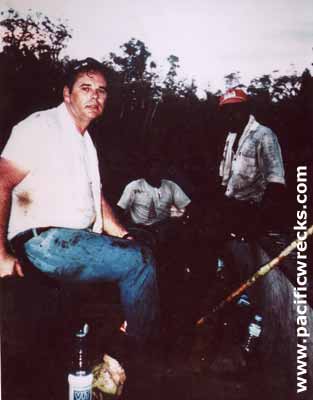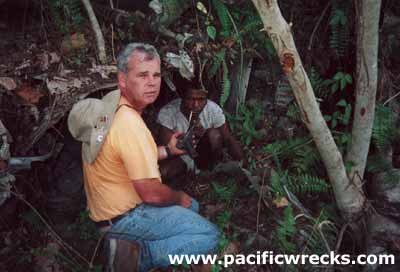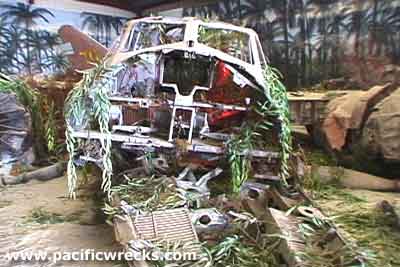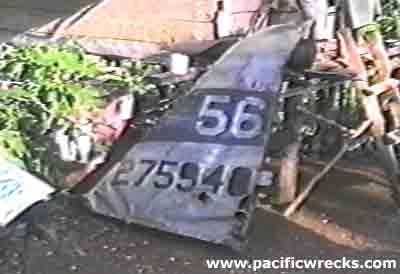In memory: Bruce Fenstermaker passed away April 27, 2020.
Tell a little about yourself and your background
I've been married for 31 years to my
wife, Linda. We have three grown children: Malynda, Jennifer, and Greg,
and two granddaughters: Chelsie, and Rose. I grew up in Chino, California,
with my parents, Doris and Lee, and three brothers.
How did you first get interested in the Pacific?
 I guess you could say I inherited a love of
aircraft from my father. His father (my granddad) used to take him
to the Cleveland Air Races with his siblings when they were small children,
something he had fond memories of as an adult. As a kid, I rode my bike seven miles one way from my
home to Chino Airport. At Chino I got to wash and work on planes and
become a general nuisance to the aircraft owners. The guys, who owned
WWII era aircraft, didn't seem to mind too much, though, something
that I was thankful for.
I guess you could say I inherited a love of
aircraft from my father. His father (my granddad) used to take him
to the Cleveland Air Races with his siblings when they were small children,
something he had fond memories of as an adult. As a kid, I rode my bike seven miles one way from my
home to Chino Airport. At Chino I got to wash and work on planes and
become a general nuisance to the aircraft owners. The guys, who owned
WWII era aircraft, didn't seem to mind too much, though, something
that I was thankful for.
The group of guys my age I chummed around with had
pretty much the same interest as I did- planes. We were known as
the
Chino Kids- a group that were willing to beg, borrow, and steal to
simply be near the aircraft at the Airport. Being able to hang out
with the Planes of Fame Museum founder Edward Maloney was an added bonus. I enlisted in
the U.S. Army Helicopter Program during the Vietnam War, but had
an uneventful stateside career.
When
did you begin traveling to the Pacific?
 In 1983, dissatisfied with my career as it was,
I set off to salvage aircraft abroad, though not without my wife’s
blessing and encouragement. In starting out, I knew that most of the good aircraft
had already been salvaged and the likelihood of my finding easily accessible
aircraft was zero to nil, so I spent much of the first year researching
various locations in the South Pacific to get a feel for what I was
getting myself into. I then spoke to a good friend and neighbor, Soup Hoisington,
looking for some pointers. Soup was the owner of a WWII aircraft modification
and repair center Aero Sport at Chino Airport and had in the past
worked with David Tallichet and others in recovering aircraft
five years prior to my arriving on the scene.
In 1983, dissatisfied with my career as it was,
I set off to salvage aircraft abroad, though not without my wife’s
blessing and encouragement. In starting out, I knew that most of the good aircraft
had already been salvaged and the likelihood of my finding easily accessible
aircraft was zero to nil, so I spent much of the first year researching
various locations in the South Pacific to get a feel for what I was
getting myself into. I then spoke to a good friend and neighbor, Soup Hoisington,
looking for some pointers. Soup was the owner of a WWII aircraft modification
and repair center Aero Sport at Chino Airport and had in the past
worked with David Tallichet and others in recovering aircraft
five years prior to my arriving on the scene.
 Speak
your Salvage work for Museums
Speak
your Salvage work for Museums
With that learning experience, I returned back home
to the States, moderately disheartened but thinking that there had
to be some some way to cut through the red tape. After about four years of surveys and
careful negotiations with the Indonesian military and civilian
government, I was granted through exchanges permission to salvage
complete aircraft.
 Like the story of the lost Dutchman’s
mine, one area called Babo Airfield had rare aircraft and word
was getting out. Time was running out so in order to beat the competition. I recovered A6M3
Zero 3869. The
aircraft was recovered and subsequently brought back to the U.S.
and sold
to Santa
Monica Museum of Flying. After the sale I was approached by Santa Monica about a joint venture and I agreed, recovering G4M1
1208, D4Y1 Judy and Ki-61 Tony, plus the
partial shipment of an A6M3 Model 22 Zero,
A6M3 Model 32 Zero and Ki-45 Nick. The joint venture soured, spelling financial
destruction for me. It broke my heart.
Like the story of the lost Dutchman’s
mine, one area called Babo Airfield had rare aircraft and word
was getting out. Time was running out so in order to beat the competition. I recovered A6M3
Zero 3869. The
aircraft was recovered and subsequently brought back to the U.S.
and sold
to Santa
Monica Museum of Flying. After the sale I was approached by Santa Monica about a joint venture and I agreed, recovering G4M1
1208, D4Y1 Judy and Ki-61 Tony, plus the
partial shipment of an A6M3 Model 22 Zero,
A6M3 Model 32 Zero and Ki-45 Nick. The joint venture soured, spelling financial
destruction for me. It broke my heart.
 Yet, for all of the bad, there was some silver lining. During
those first surveys, I found some planes, alright, but that
was not
all. Quietly resting in the cockpit of a downed P-38 cradled
in the jungle trees (to my shock and surprise)
were the remains of an American pilot, canopy closed. I know it may sound
strange, but looking at this long dead hero, my priorities shifted.
Yet, for all of the bad, there was some silver lining. During
those first surveys, I found some planes, alright, but that
was not
all. Quietly resting in the cockpit of a downed P-38 cradled
in the jungle trees (to my shock and surprise)
were the remains of an American pilot, canopy closed. I know it may sound
strange, but looking at this long dead hero, my priorities shifted.
What got you interested in
MIA cases?
 I had never expected to or wanted
to find MIAs, I’d been thinking all along that the missing
air crew reports were just left alone- not updated as the men
were recovered through
the years. I recall a letter I sent to my wife not long after
my discovery, “If I don’t bring any planes home, at least
one MIA will come home.” As time went on thoughts of the
huge profits the planes brought in became less and less as thoughts
of sending these men back home at last became more and more frequent-
all of this even before the joint venture fiasco. I then started
using the money from the aircraft parts more and more on MIA research
that turned into success.
I had never expected to or wanted
to find MIAs, I’d been thinking all along that the missing
air crew reports were just left alone- not updated as the men
were recovered through
the years. I recall a letter I sent to my wife not long after
my discovery, “If I don’t bring any planes home, at least
one MIA will come home.” As time went on thoughts of the
huge profits the planes brought in became less and less as thoughts
of sending these men back home at last became more and more frequent-
all of this even before the joint venture fiasco. I then started
using the money from the aircraft parts more and more on MIA research
that turned into success.
P-47D Thunderbolt Serial Number 75940
Pilot Frankfort April 27, 1944
Thank you for the interview, Mr. Fenstermaker.
References
Dignity Memorial - Bruce Edward Fenstermaker October 30, 1949 – April 27, 2020